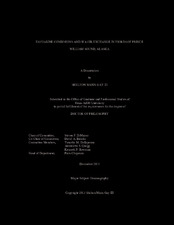| dc.description.abstract | This dissertation addresses spatial variation in physical properties of small fjords in Prince William Sound (PWS), Alaska between 1994 and 1997 and circulation and water exchange in 2007 and 2008 at Simpson Bay, a small subarctic fjord located in eastern PWS. Ancillary weather data were also collected at Simpson in both years. Principal component (PC) analysis is used to quantify variance in freshwater content (FWC) and temperature among sites and regression analysis is used to compare mean FWCs with watershed to fjord basin area ratios (WSR), watershed areas and maximum elevations. The results show that the principal components explaining > 90% of the variance in FWC occur in two statistical modes that respectively indicate total freshwater input from all sources and the vertical distribution from mixing, advection and in certain cases internal waves. The spatial variation of temperature is more complex due to local differences in solar heating combined with cooling effects of alpine runoff and subsurface water advected from tidewater glacial fjords. In 1994, this type of advection influenced the hydrography in western PWS possibly as far south as N. Elrington Pass, and in 1996 and 1997, fjords influenced by glacial advection again exhibit atypically high FWC values due to subsurface freshening.
The currents at Simpson Bay reveal a complex flow structure forced by tides interacting with bathymetry and moderated by stratification, tidal volume flux, internal waves and winds. Baroclinic currents form the principal mechanism forcing exchange, shown by both an imbalance in tidal volume transports and highly coherent low frequency variations in nearsurface T/S properties. Surface exchange by both winds and currents are also inferred by low to high frequency oscillations in the T/S wavelet spectra, and internal waves are evident from fluctuations in both the pycnocline depths during tide cycles and by vertical oscillations of moored temperatures. Vertical diffusivity and the efficiency of work performed by mixing from internal waves in comparison to available tidal energy indicate that deep diffusivity exceeds the available tidal energy on O (10 to 100). As such, changes in deep density in both basins over time cannot be alone due to vertical mixing and must come from advection of subsurface water from outside the fjord, and possibly submarine ground water discharge in the northern basin. | en |


